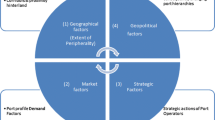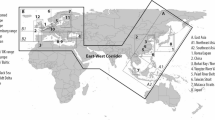Abstract
The worldwide network of container transport services is becoming increasingly diffuse. The different strategies of shipping lines, the balance of power between shipping lines and shippers and constraints related to inland transportation all have a potential impact on the development of maritime shipping networks. Moreover, strategic alliances between the port and the shipping industry, which have both been driven by strong concentration processes and vertical integration, have a profound influence on the maritime network structure and also on the grade of integration of a region in the global maritime transport network. This paper seeks to understand the evolution of maritime networks in and between two differently developed regions. The focus is on the trade route and networks between the West Coast of South America and Northern Europe. The paper analyses the network structures and the behaviour of shipping lines in different economic contexts and port systems. Current and historical developments in the two regions under study have led to their relative position within the global maritime network and illustrate the potential implications of being peripheral or central in this network. The empirical results are compared with known strategies of shipping lines. The authors aim to answer the question of how far the configuration of hinterlands determines calling patterns and if strategic alliances and vertical integration reduce footloose behaviour of shipping lines. Further, we discuss how far, under the current configuration, shipping lines influence port development, and also the reverse situation of how far port accessibility and performance influence maritime network developments. The two region approach provides insights on the constraining factors of maritime network development between two differently developed regions and the associated implications for trade development.












Similar content being viewed by others
References
Barros, C. P., & Athanassiou, M. (2004). Efficiency in european seaports with DEA: Evidence from Greece and Portugal. Maritime Economics and Logistics, 6, 122–140.
Chang, Y. T., Lee, S.-Y., Tongzon, J., Chou, C. C., Chu, C. W. & Liang, G. S. (2008). Port selection factors by shipping lines: Different perspectives between trunk liners and feeder service providers, Marine Policy, (Forthcoming).
Chou, C. C., Chu, C. W., & Liang, G. S. (2003). Comparison of two models for port choice. Journal of Maritime Quarterly, 12, 45–61.
Cullinane, K., & Khanna, M. (2000). Economies of scale in large containerships: optimal size and geographical implications. Journal of Transport Geography, 8, 181–195.
Drewry (2006). The Drewry container market quarterly, Volume Seven, March 2006. London: Drewry Shipping Consultants.
Fagerholt, K. (2004). Designing optimal routes in a liner shipping problem. Maritime Policy and Management, 31(4), 259–268.
Frémont, A., & Soppé, M. (2007). Northern European range: shipping line concentration and port hierarchy. In J. Wang, T. Notteboom, D. Olivier, & B. Slack (Eds.), Ports, cities, and global supply chains (pp. 105–120). Ashgate: Alderschot.
Guy, E. (2003). Shipping lines networks and the integration of South America trades. Maritime Policy and Management, 30, 231–242.
Guy, E., & Urli, B. (2006). Port Selection and multi-criteria analysis: An application to the montreal-New York alternative. Maritime Economics and Logistics, 8, 169–186.
Hayuth, Y. (1981). Containerization and the load centre concept. Economic Geography, 57(2), 160–176.
Huybrechts, M., Meersman, H., Van De Voorde, E., Van Hooydonk, E., Verbeke, A., & Winkelmans, W. (2002). Port competitiveness: an economic and legal analysis of the factors determining the competitiveness of seaports. Antwerp: Editions De Boeck.
Lirn, T. C., Thanopoulou, H. A., Beynon, M. J., & Beresford, A. K. C. (2004). An application of AHP on transhipment port selection: a global perspective. Maritime Economics and Logistics, 6, 70–91.
Magala, M., & Sammons, A. (2008). A new approach to port choice modelling. Maritime Economics and Logistics, 10(1–2), 9–34.
Malchow, M., & Kanafani, A. (2001). A disaggregate analysis of factors influencing port selection. Maritime Policy and Management, 28, 265–277.
Márquez Ramos, L., Martínez Zarzoso, I., Pérez García, E. & Wilmsmeier, G., (2006). The interrelationship of maritime network connectivity, transport costs and maritime trade. 14th annual congress of the international association of maritime economists (IAME) in Melbourne, July 3–5 2006.
Murphy, P., & Daley, J. (1994). A comparative analysis of port selection factors. Transportation Journal, 3, 15–21.
Murphy, P., Daley, J., & Dalenberg, D. (1992). Port selection criteria: an application of a transportation research framework. Logistics and Transportation Review, 28, 237–255.
Nir, A.-S., Lin, K., & Liang, G.-S. (2006). Port choice behaviour - from the perspective of the shipper. Maritime Policy and Management, 30, 165–173.
Notteboom, T. (2002). Consolidation and contestability in the European container handling industry. Maritime Policy and Management, 29, 257–269.
Notteboom, T. (2004). A carrier’s perspective on container network configuration at sea and on land. Journal of International Logistics and Trade, 1(2), 65–87.
Notteboom, T. (2009). Complementarity and substitutability among adjacent gateway ports. Environment and Planning A, 41, 743–762.
Notteboom, T., & Rodrigue, J.-P. (2005). Port regionalization: towards a new phase in port development. Maritime Policy and Management, 32, 297–313.
Parola, F., & Musso, E. (2007). Market structures and competitive strategies: the carrier-stevedore arm wrestling in northern European ports. Maritime Policy and Management, 34(3), 259–278.
Sánchez, R. J., & Wilmsmeier, G. (2005). Provisión de Infraestructura de Transporte en América Latina: Experiencia reciente y Problemas observados. CEPAL Serie No 94 de Recursos Naturales e Infraestructura. Chile: Santiago.
Sánchez, R. J., Wilmsmeier, G., & Doerr, O., (2008). Interport competition in a single market: lessons from the central chilean port range. Proceedings of 2008 international conference on shipping, port and logistic management. Kainan University, Taiwan, March 28–29, 2008.
Song, D. W., & Yeo, K. T. (2004). A competitive analysis of chinese container ports using the analytic hierarchy process. Maritime Economics and Logistics, 6, 34–52.
Soppé, M., Parola, F., & Frémont, A. (2009). Emerging inter-industry partnerships between shipping lines and stevedores: From rivalry to cooperation? Journal of Transport Geography, 17(1), 10–20.
Taaffe, E. J., Morrill, R. L., & Gould, P. R. (1963). Transport expansion in underdeveloped countries: A comparative analysis. Geographical Review, 53, 503–529.
Tiwari, P., Itoh, H., & Doi, M. (2003). Shippers’ port and carrier selection behavior in China: A discrete choice analysis. Maritime Economics and Logistics, 5, 23–39.
Wiegmans, B., Van Der Hoest, A., & Notteboom, T. (2008). Port and terminal selection by deep-sea container operators. Maritime Policy and Management, 35(6), 517–534.
Wilmsmeier, G., & Hoffmann, J. (2008). Liner shipping connectivity and port infrastructure as determinants of freight rates in the caribbean. Maritime Economics and Logistics, 10, 130–151.
Wilmsmeier, G., & Sánchez, R., (2008). Liner shipping networks, market concentration and market power. Evidence from the West Coast of South America, IAME conference proceedings Dalian, China, 2–4 April 2008.
Wilmsmeier, G., & Sánchez, R. J., (2008). Shipping networks in international containerized trade—market evolution on the west coast of South America. In Handbook of container shipping Vol. 2 ISL, ISSN 0174-5728, Bremen, Germany.
Author information
Authors and Affiliations
Corresponding author
Rights and permissions
About this article
Cite this article
Wilmsmeier, G., Notteboom, T. Determinants of liner shippping network configuration: a two-region comparison. GeoJournal 76, 213–228 (2011). https://doi.org/10.1007/s10708-009-9333-2
Published:
Issue Date:
DOI: https://doi.org/10.1007/s10708-009-9333-2




